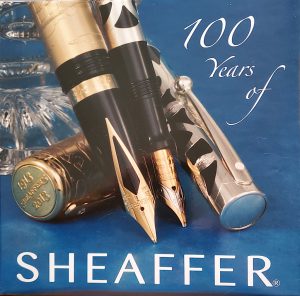One might think that a book written by the Sheaffer corporation about the Sheaffer corporation might be a definitive history of the company, but one might be wrong.

This is the book cover to “100 Years of Sheaffer.” It is a very attractive coffee table book that seems to get some of the facts and history muddled if not completely wrong.
“100 Years of Sheaffer” is a beautiful coffee table book published by Sheaffer in 2013 to celebrate the first century of the company from 1913, when it officially incorporated, to the then present 2013. The pages are thick and the photography is excellent. Clearly, Sheaffer intended for this book to last another 100 years.
Unfortunately, the information inside the book isn’t as accurate as one might hope. At the time, the Sheaffer Pen Company had been owned by Bic, after changing hands a few other times since the Sheaffer family sold it in the 1960s. Perhaps, their own archives were diminished or this became a side project that was more of a nuisance than a labor of love.
The book opens with a few bland, general statements by Bic chairman Bruno Bich; John D. Sheaffer (the founder Walter Sheaffer’s grandson) and Sheaffer’s general manager Tim Williams. Then the uncredited author begins the narrative for the book. True Sheaffer experts will be upset by some glaring mistakes, such as ignoring the Sheaffer Touchdown filling system and then calling those pens the Snorkel and Snorkel Thin Model of 1949 and ’50 and then getting into how the Snorkel was put on the market in 1952. It also discusses how the famous Sheaffer inlaid nib was first introduced on the Pen for Men, when I’m pretty sure it got its debut with the Sheaffer Compact pens a year or two earlier, which aren’t even mentioned in the book, which is surprising given how they were early cartridge pens. Much of the information in the book is accurate, but these inconsistencies and omissions chip away at its credibility.
Each chapter focuses on a decade of Sheaffer production, and it starts with a brief overview of the history of that decade. Yet, they seem to get some basic history a little wrong, too. As the history is more pop-culture based, it is weird how they refer to the movie “King Kong” as an early Technicolor film, in the same sentence with “Gone with the Wind” and “The Wizard of Oz.” The latter two films were famously early color films from 1939, while “King Kong” was a black-and-white film from 1933. In the 1940s section it discusses how Humphrey Bogart and Ava Garner became huge stars in the classic film noir movies “The Maltese Falcon” and “Casablanca.” Yes, Bogie became a household name for his performances in those films, but Garner didn’t appear in either of them. True fans of noir would also never consider “Casablanca” film noir, either.
While similar books focus heavily on identifying pens based on their production dates and model names, this book doesn’t get into as many of these details. It does feature some great pens and samples of original advertising, but the very best examples are of the pens and ads come from the Bic era from 1997 to 2013. Even though I cannot prove it definitively, it seems as if they get the production dates wrong on some of their own pens of that era.
The general errors in the book should have been corrected before publication, as the true facts were already well established and known by pen collectors in 2013. Another surprising element of the book is that many of the pens photographed were not cleaned up. While they might have been from Sheaffer’s archives, many were tarnished and/or even showing some corrosion on the metal parts. By 2013, there were already many well established vintage pen repairers who could have gotten those pens gleaming for their big day with the camera. The photos were well lit and focused. It just seems as if they could have done a better job prepping the pens for such an important book.
In the final analysis, it is a well-made book with some good information. Unfortunately, you can’t trust it as the definitive source material identifying and dating Sheaffer pens.


 Shopping Cart
Shopping Cart




